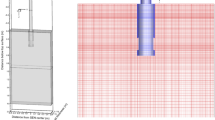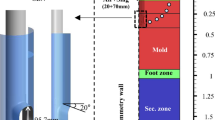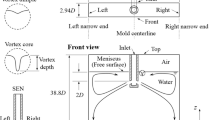Abstract
In the present study, the high-temperature quantitative measurement of velocity near the mold surface, water modeling, and numerical simulation were conducted under a casting speed of 1.4 m/min and three argon flow rates of 6, 9, and 12 L/min to investigate the flow field and mold flux entrainment in the continuous casting (CC) mold with the section of 1300 × 230 mm2. When tracing argon bubbles in the Lagrangian frame, algebraic wall-modeled large eddy simulation (WMLES) and the volume of fluid (VOF) method were applied to modeling the steel-slag two-phase flow. The VOF-to-discrete particle model (DPM) and the DPM-to-VOF transition mechanisms were introduced to track the entrained mold flux droplets of different sizes with reasonable calculation cost by adopting adaptive mesh refinement and coarsening. The numerical simulation results are in good agreement with the high-temperature measurement velocities near the mold surface and the water modeling measurement results. With the increase of the argon flow rate, the velocity near the mold surface first increases and then decreases with the flow pattern of double roll flow. The numerical simulation results of the distribution of argon bubbles are in good agreement with the high-speed photographs of the water modeling. As the argon flow rate increases, the argon bubbles are more concentrated near the nozzle with the rising probability of breaking the mold flux layer, molten steel reoxidation, and steel-slag interface instability, while the spatial distribution of small-size bubbles is relatively uniform. The high-speed photographs of the water modeling show that the mold flux entrainment is caused by the shear stress, vortex, and steel-slag interface instability, which can be simulated by the present developed mathematical model. The numerical simulation results indicate that with the increase of the argon flow rate, the percentage of mold flux entrainment droplets reintegrated into the mold flux layer decreases from more than 80 pct to less than 80 pct, while the number of droplets remains in molten steel and those possibly captured by wide and narrow faces gradually increase. The mold flux entrainment droplets that may be captured by wide and narrow faces do not exceed 1 pct of the total. Under the three working conditions, the entrainment position of most droplets is within and around one-quarter width of the mold and most droplets are entrained not far from the meniscus. Based on simulation and experimental results, the proper argon flow rate should be 6 L/min, by which the average incidence of mold flux entrainment in the automobile exposed panel decreased from 2.80 to 1.29 pct and the qualified ratio of mold liquid level fluctuation increased from 92 to 98.7 pct.
















Similar content being viewed by others
Abbreviations
- CC:
-
Continuous casting
- DPM:
-
Discrete particle model
- LES:
-
Large eddy simulation
- PIV:
-
Particle image velocimetry
- RANS:
-
Reynolds averaged Navier–Stokes
- RDM:
-
Rod deflection method
- SEN:
-
Submerged entry nozzle
- SGS:
-
Subgrid scale
- VOF:
-
Volume of fluid
- WMLES:
-
Wall-modeled large eddy simulation
- i, j, k :
-
Indices for different spatial coordinate directions (—)
- X, Y, Z :
-
Spatial coordinates (m)
- \( \overset{\rightharpoonup} {g} \) :
-
Gravity acceleration vector (m/s2)
- ρ :
-
Weighted average density of continuous flow and discrete phases in the cell (kg/m3)
- t :
-
Time (s)
- \(\overset{\rightharpoonup}{{v}_{l}}\) :
-
Velocity of continuous flow phase (m/s)
- α l :
-
Volume fraction of continuous flow phase
- ρ l :
-
Density of continuous flow phase (kg/m3)
- p :
-
Pressure (Pa)
- μ :
-
Equivalent viscosity (Pa·s)
- μ l :
-
Liquid viscosity (Pa·s)
- μ t :
-
Turbulent viscosity (Pa·s)
- \(\overset{\rightharpoonup}{{F}_{k}}\) :
-
Force applied by the discrete phase on the continuous flow phase (N/m3)
- \(\overset{\rightharpoonup}{{F}_{\sigma }}\) :
-
Interface tension between molten steel and mold flux (N/m3)
- Ω:
-
Vorticity (1/s)
- V d , i :
-
Volume of discrete phase in the cell (m3)
- V cell :
-
Volume of the cell (m3)
- Φ(x,t):
-
Variable filtered by LES (—)
- \( \bar{\Phi }(x,t) \) :
-
Filtered value of Φ(x,t)
- ξ :
-
Filter function (—)
- \(\overset{\rightharpoonup}{\mathbf{x}}\) :
-
Spatial vector (—)
- \(\overset{\rightharpoonup}{{\mathbf{x}}^{\mathbf{^{\prime}}}}\) :
-
Offset vector from \(\overset{\rightharpoonup}{\mathbf{x}}\) (—)
- τ ij , τ kk :
-
Subgrid-scale stresses (Pa)
- \(\delta_{ij}\) :
-
Kronecker delta (—)
- κ :
-
Constant, 0.41 (—)
- C S mag :
-
Constant, 0.2 (—)
- d w :
-
Wall distance (m)
- v τ :
-
Viscous velocity near wall (m/s)
- ν :
-
Kinematic viscosity (m2/s)
- h max :
-
Maximum edge length for the hexahedral cell (m)
- h wn :
-
Wall-normal grid spacing (m)
- C w :
-
Constant, 0.15 (—)
- m b :
-
Discrete particle mass (kg)
- \(\overset{\rightharpoonup}{{v}_{\text{b}}}\) :
-
Discrete particle velocity (m/s)
- \(\overset{\rightharpoonup}{{F}_{\text{D}}}\) :
-
Drag force (N)
- \(\overset{\rightharpoonup}{{F}_{\text{P}}}\) :
-
Pressure gradient force (N)
- \(\overset{\rightharpoonup}{{F}_{\text{f}}}\) :
-
Buoyancy (N)
- \(\overset{\rightharpoonup}{{F}_{\text{V}}}\) :
-
Virtual mass force (N)
- \(\overset{\rightharpoonup}{{F}_{\text{g}}}\) :
-
Gravity (N)
- \(\overset{\rightharpoonup}{{F}_{\text{L}}}\) :
-
Lift force (N)
- C D :
-
Drag coefficient (—)
- C L :
-
Lift coefficient (—)
- C V :
-
Virtual mass force coefficient, taken as 0.5 (—)
- d b :
-
Discrete particle diameter (m)
- ρ b :
-
Discrete particle density (kg/m3)
- C D,visc :
-
Drag coefficient in the viscous region (—)
- C D,sphere :
-
Spherical drag coefficient (—)
- a 1, a 2, a 3 :
-
Parameters varying with Reynolds number (—)
- C D,dist :
-
Drag coefficient in the distorted regime (—)
- \({v}_{t}\) :
-
Terminal velocity (m/s)
- \(\Delta \rho\) :
-
Density difference between continuous flow phase and discrete phase (kg/m3)
- Mo:
-
Morton number (—)
- σ :
-
Interfacial tension coefficient (N/m)
- Eo:
-
Eotvos number (—)
- μ l.ref :
-
Reference viscosity of continuous flow phase (Pa·s)
- C D,cap :
-
Drag coefficient in the spherical cap regime (—)
- \({\alpha }_{\text{steel}}\) :
-
Volume fraction of molten steel in the cell (—)
- \({\alpha }_{\text{slag}}\) :
-
Volume fraction of mold flux in the cell (—)
- \({\rho }_{\text{steel}}\) :
-
Density of molten steel (kg/m3)
- \({\rho }_{\text{slag}}\) :
-
Density of mold flux (kg/m3)
- \({\mu }_{\text{steel}}\) :
-
Viscosity of molten steel (Pa·s)
- \({\mu }_{\text{slag}}\) :
-
Viscosity of mold flux (Pa·s)
- \(\Delta p\) :
-
Pressure drop at the interface between molten steel and mold flux (Pa)
- R i, R j :
-
Principal radii of curvature at the interface between molten steel and mold flux (m)
- k :
-
Curvature at the interface between molten steel and mold flux
- \(\overset{\rightharpoonup}{{\mathbf{n}}_{0}}\) :
-
Unit normal vector at the interface between molten steel and mold flux (—)
- \(\overset{\rightharpoonup}{\mathbf{n}}\) :
-
Normal vector at the interface between molten steel and mold flux (—)
- \(\overset{\rightharpoonup}{{F}_{\text{vol}}}\) :
-
Interfacial tension expressed as volume force (N/m3)
- Fr:
-
Froude number (—)
- \(\overset{\rightharpoonup}{{v}_{\text{lm}}}\) :
-
Velocity of continuous flow phase in water modeling (m/s)
- \(\overset{\rightharpoonup}{{v}_{\text{lp}}}\) :
-
Velocity of continuous flow phase in prototype (m/s)
- \(\overset{\rightharpoonup}{{v}_{\text{bm}}}\) :
-
Velocity of air bubble in water modeling (m/s)
- \(\overset{\rightharpoonup}{{v}_{\text{bp}}}\) :
-
Velocity of argon bubble in prototype (m/s)
- d m :
-
Feature size in water modeling (m)
- d p :
-
Feature size in prototype (m)
- λ :
-
Geometric ratio of water modeling (—)
- Fr' :
-
Modified Froude number (—)
- d bm :
-
Diameter of discrete particle in water modeling (m)
- d bp :
-
Diameter of discrete particle in prototype (m)
- \(\rho_{{{\text{water}}}}\) :
-
Density of water (kg/m3)
- \({\rho }_{\text{argon}}\) :
-
Density of argon gas in molten steel (kg/m3)
- \({\rho }_{\text{air}}\) :
-
Density of air (kg/m3)
- \({Q}_{\text{air}}\) :
-
Volume flow rate of air (m3/s)
- \({Q}_{\text{argon}}\) :
-
Volume flow rate of argon gas at normal temperature and pressure (m3/s)
- We:
-
Weber number (—)
- σ bm :
-
Interfacial tension coefficient between water and air (N/m)
- σ bp :
-
Interfacial tension coefficient between molten steel and argon gas (N/m)
- σ m :
-
Interfacial tension coefficient between water and silicone oil (N/m)
- σ p :
-
Interfacial tension coefficient between molten steel and mold flux (N/m)
- Wem :
-
Weber number in water-silicone oil system (—)
- Wep :
-
Weber number in molten steel-mold flux system (—)
- Weair bubble :
-
Air bubble Weber number (—)
- Weargon bubble :
-
Argon bubble Weber number (—)
- ρ silicone oil :
-
Density of silicone oil (kg/m3)
- ρ mold flux :
-
Density of mold flux (kg/m3)
References
X.Q. Pan, J. Yang, J. Park, and H. Ono: Int. J. Miner. Metall. Mater., 2020, vol. 27(11), pp. 1489–98.
T.T. Li, J. Yang, G.B. Li, W. Kang, Y. Lin, and J.S. Meng: Ironmak. Steelmak., 2021, https://doi.org/10.1080/03019233.2021.2004534.
X. Wang, S. Zheng, Z. Liu, and M. Zhu: Steel Res. Int., 2020, vol. 91 (2), p. 1900415.
Y. Wang, S. Yang, F. Wang, and J. Li: Materials, 2019, vol. 12 (11), p. 1774.
M. Saeedipour, S. Puttinger, and S. Pirker: International Conference on Computational Fluid Dynamics in the Oil & Gas, Trondheim, 2017, p. 1.
W. Chen, L. Zhang, Y. Wang, S. Ji, Y. Ren, and W. Yang: Powder Technol., 2021, https://doi.org/10.1016/j.powtec.2021.05.101.
P. Sulasalmi, A. Kärnä, T. Fabritius, and J. Savolainen: ISIJ Int., 2009, vol. 49(11), pp. 1661–67.
K.T. Zhang, J.H. Liu, and H. Cui: Steel Res. Int., 2020, vol. 91 (2), p. 1900437.
J.H. Lee, S. Han, H.J. Cho, and I.S. Park: Metall. Mater. Trans. B., 2021, vol. 52B, pp. 2715–25.
J.H. Lee, S. Han, H.J. Cho, and I.S. Park: Metall. Mater. Trans. B., 2021, vol. 52B, pp. 178–89.
S.M. Cho, B.G. Thomas, and S.H. Kim: Metall. Mater. Trans. B., 2019, vol. 50B, pp. 52–76.
M. Gan, W. Pan, Q. Wang, X. Zhang, and S. He: Metall. Mater. Trans. B., 2020, vol. 51B, pp. 2862–70.
M. Iguchi, J. Yoshida, T. Shimizu, and Y. Mizuno: ISIJ Int., 2000, vol. 40 (7), pp. 68591.
X. Li, B. Li, Z. Liu, R. Niu, Y. Liu, C. Zhao, C. Huang, and H. Qiao: Metals, 2019, vol. 9 (1), p. 7.
P. Zhao, Q. Li, S.B. Kuang, and Z. Zou: High Temp. Mater. Process., 2017, vol. 36(5), pp. 551–65.
Y.B. Yin and J.M. Zhang: ISIJ Int., 2021, vol. 61(3), pp. 853–64.
X.J. Zhao, X.L. Li, and J.Y. Zhang: Metals, 2021, vol. 11 (2), p. 374.
B. Rietow and B.G. Thomas: AISTech 2008 Steelmaking Conf. Proc., Pittsburgh, PA, 2008, p. 1.
H. Zhou, L. Zhang, Q. Zhou, and W. Chen: Steel Res. Int., 2021, vol. 92 (4), p. 2000547.
H. Zhou, L. Zhang, W. Chen, Y. Ren, and W. Yang: Metall. Mater. Trans. B., 2021, vol. 52B, pp. 1106–17.
T. Zhang, J. Yang, and P. Jiang: Metals, 2019, vol. 9 (1), p. 36.
P. Jiang, J. Yang, T. Zhang, G. Xu, H. Liu, J. Zhou, and W. Qin: Metals, 2020, vol. 10 (1), p. 9.
T. Zhang, J. Yang, G. Xu, H. Liu, J. Zhou, and W. Qin: Int. J. Miner. Metall. Mater., 2021, vol. 28(2), pp. 238–48.
C. Ma, W. He, H. Qiao, C. Zhao, Y. Liu, and J. Yang: Metals, 2021, vol. 11 (2), p. 261.
R. Clift, J.R. Grace, and M.E. Weber: Bubbles, Drops, and Particles, Academic Press, New York, NY, 1978, p. 30.
S.A.J. Morsi and A.J. Alexander: J. Fluid Mech., 1972, vol. 55 (2), pp. 193–208.
J.U. Brackbill, D.B. Kothe, and C. Zemach: J. Comput. Phys., 1992, vol. 100(2), pp. 335–54.
Acknowledgments
This work was supported by the National Natural Science Foundation of China (Grant No. U1960202).
Conflict of interest
On behalf of all of the authors, the corresponding author states that there is no conflict of interest.
Author information
Authors and Affiliations
Corresponding author
Additional information
Publisher's Note
Springer Nature remains neutral with regard to jurisdictional claims in published maps and institutional affiliations.
Rights and permissions
About this article
Cite this article
Liu, YB., Yang, J. & Lin, ZQ. Mathematical Modeling of Mold Flow Field and Mold Flux Entrainment Assisted With High-Temperature Quantitative Velocity Measurement and Water Modeling. Metall Mater Trans B 53, 2030–2050 (2022). https://doi.org/10.1007/s11663-022-02495-5
Received:
Accepted:
Published:
Issue Date:
DOI: https://doi.org/10.1007/s11663-022-02495-5




